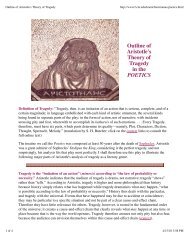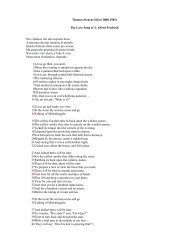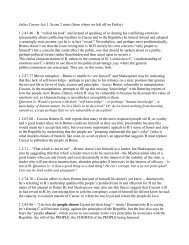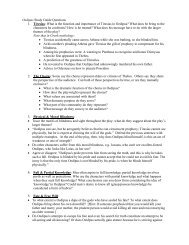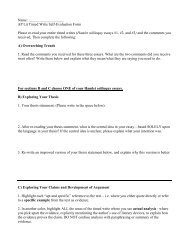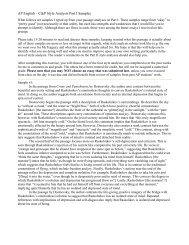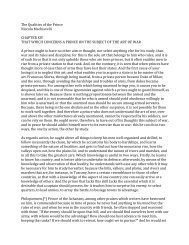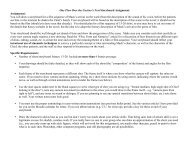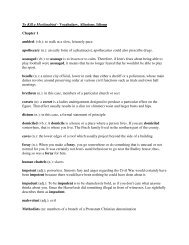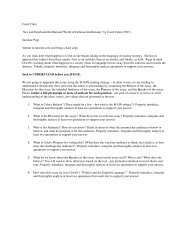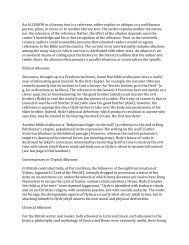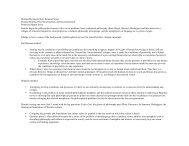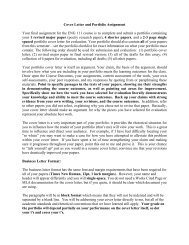"Black like Me"
"Black like Me"
"Black like Me"
You also want an ePaper? Increase the reach of your titles
YUMPU automatically turns print PDFs into web optimized ePapers that Google loves.
"<strong>Black</strong> <strong>like</strong> Me"<br />
Monday, Mar. 28, 1960<br />
On the way to Hattiesburg, Miss., the bus pulled into a rest stop, and the white passengers got<br />
off. When one of the colored passengers, a big man in dark glasses, tried to follow them, the<br />
driver blocked his way. "Where do you think you're going?" he demanded. "I'd <strong>like</strong> to go to the<br />
rest room," the passenger said. "Does your ticket say for you to get off here?" asked the driver.<br />
"No, sir," said the passenger, "I'm going to Hattiesburg." The driver shut the bus door. "Then<br />
you get back in your seat." he commanded, "and don't you move till we get to Hattiesburg."<br />
Meekly, the passenger did as he was told.<br />
What the driver did not know was that the man he had just intimidated was not a Negro but a<br />
white. He was John Howard Griffin, 39, Dallas-born author (The Devil Rides Outside) on<br />
assignment for Sepia magazine, a Negro monthly (circ. 61,975) published in Fort Worth. His<br />
skin darkened by pills,* ultraviolet treatment and vegetable dye, his straight brown hair shaved<br />
to the poll, he was touring the Deep South to see how it felt to wear the black man's skin. In the<br />
current issue of Sepia, in the first of five installments. Griffin began telling what it was <strong>like</strong>.<br />
"The Hate Stare." Accepted without question as a Negro by both races, Griffin drifted through<br />
four states—Louisiana, Mississippi, Alabama, and Georgia—well-dressed, comparatively wellheeled<br />
($200 in traveler's checks), obviously well-educated, under his own name and ready to<br />
reveal the truth to anyone who asked. No one asked. His skin was black, and that was enough.<br />
Throughout the South, Griffin encountered what he calls "the hate stare." Offering his seat to a<br />
white woman in a New Orleans streetcar, he watched her face stiffen into hostility. "What are<br />
you looking at me <strong>like</strong> that for?" she asked sharply, and turned away muttering, "They're getting<br />
sassier every day." Hitchhiking through Alabama, he was picked up by a white truck driver who<br />
inquired, with a leer, whether Griffin's wife had ever slept with a white man, informed him that<br />
"we're doing your race a favor to get some white blood into your kids." A factory foreman in<br />
Mobile, to whom Griffin applied for a job, told him coldly: "We don't want you people. We're<br />
gradually getting you people weeded out from the better jobs at this plant. Pretty soon we'll<br />
have it so the only kind of jobs you can get here are the ones no white man would have."<br />
Wherever he went, he could get only the most menial work.<br />
The Dark Night. Griffin began his masquerade with the feeling that as a Southern white, he<br />
lacked compassion for the Negro, as well as a true understanding of the Negro's lot. His fourweek<br />
journey strengthened both of these impressions. "I had no idea what they have to go<br />
through," he said. "I literally bawled myself to sleep some nights. I learned that when it is night,<br />
when it is dark, then the Negro feels safest. Langston Hughes's line, 'Night coming tenderly/<br />
<strong>Black</strong> <strong>like</strong> me,'* has real meaning."<br />
After four weeks as a Negro, Griffin harbors new doubts about his own race. "I <strong>like</strong> to see good<br />
in the white man," he said last week. "But after this experience, it's hard to find it in the<br />
Southern white."<br />
You will keep a notebook for this unit. In your notebook you will take notes on class<br />
discussions and record your answers to study questions (below). I will be collecting your<br />
notebook at the end of the unit.
1. Read the Preface and the journal on October 28 th . Explain why Griffin wrote this book? What is its<br />
purpose?<br />
2. On page 10 one of the FBI men tells Griffin, “As soon as they see you, you’ll be a Negro and that’s all<br />
they’ll ever want to know about you.” Interpret this quote. What does it say about life in the South?<br />
3. On page 13 Griffin has a conversation with his doctor about the racism that occurs within the black<br />
community at this time. Explain this racism. Why do you think this is taking place? Why do you think<br />
several people buy into this idea?<br />
4. On page 17 Griffin has an awkward encounter with a man and has no idea what to do in his new social<br />
setting. Think of a time when you had an awkward moment <strong>like</strong> this in a new setting or with new people.<br />
Describe this experience, how you handled it, and how it made you feel.<br />
5. Refer back to the conversation in question #3 note that that took place between two white men. Compare<br />
and contrast that conversation to the one in the last few paragraphs on page 20.<br />
6. Page 25-26 List the rules of “riding the bus” posted on a black Catholic church. This was a silent protest<br />
initiated by several black ministers, including Reverend Martin Luther King Junior. Choose two of the rules<br />
and explain why you think each one was selected as one of only 7 rules in this risky endeavor.<br />
7. On page 31 Griffin discusses his dinner experience with Joe. Keep in mind Joe shines shoes for a living.<br />
Why do you think he treats the “beggar” so poorly? What would be his motive? How is this ironic?<br />
8. How does Griffin experience racism as a black man on pages 36-40? Explain.<br />
9. Explain the “economic injustice” described on pages 42-43.<br />
10. What happens to Griffin as he peers in the window of restaurant and reads the menu? Explain a time when<br />
you were given similar body language, why do you believe you were treated that way?<br />
11. On page 48 Griffin explains why many black people don’t pursue education through music, art, or literature.<br />
Why is this?<br />
12. Look at Griffin’s reaction to the paper on page 49. He gives the rest of the world’s opinions of the United<br />
States. Do you think this is accurate? How do other country’s look at the U.S. today? Are they right?<br />
13. What lie does Christophe tell Griffin on the bus? Why do you think he lies about this?<br />
14. On his way to Mississippi Griffin is warned to “watch himself.” What was he warned about specifically?<br />
15. What questions does Griffin ask himself after entering the tavern on page 67?<br />
16. Why does Griffin decide against writing a letter to his wife on page 69?<br />
17. On page 72 Griffin draws a metaphorical parallel of the South to another event. What is it? Do you agree?<br />
18. How does the driver on page 86 try to bait Griffin? Why would he do this?
19. At the bottom of page 88 Griffin explains why these white men feel comfortable discussing sex openly with<br />
him as a black man, explain why. Explain how this further degrades the human life of black people in this<br />
time period.<br />
20. At the bottom of page 89 Griffin explains what actually causes “social differences” summarize this<br />
explanation in your own words.<br />
21. What does the white man at the job interview on page 98 tell Griffin the white man’s intentions are in not<br />
hiring blacks? Why do you think he so blatantly professes this?<br />
22. What conclusion does Griffin admit he’s come to on page 99?<br />
23. Explain the encounter Griffin had with the truck driver hitchhiking on his way to Alabama.<br />
24. On page 108, what does the man mean by “They got all the loopholes plugged?” Explain.<br />
25. What deep realization does Griffin make as he goes takes a bath on page 110?<br />
26. Find the simile (comparison using <strong>like</strong> or as) on page 115, and write it down.<br />
27. How is Griffin treated now he appears white when he enters the black street on Nov. 29 th ? Why?<br />
28. Read the last paragraph on page 122. Why do you think they were not taught to read and write? Explain.<br />
29. Write the example of personification on page 129.<br />
30. According to Griffin on page 131-132, what does religion do to racism? Do you agree?<br />
31. On page 134 Griffin discusses the “strides” made by Atlanta. He attributes these to three things. List all<br />
three in your own words:<br />
32. Why will this book make Griffin and his family a “target of all hate groups?”<br />
33. What gave John a “resurgence of faith in a public figure?”<br />
34. What does Griffin say is needed in order to keep things “peaceful” on page 153?<br />
35. In Griffin’s final pages he explains where racism comes from. Explain the question asked to him on page<br />
156 that describes this. Do you agree? Explain your thoughts.<br />
36. Read pages 161-188 in the Epilogue. Describe three of the “situations” or social injustices that John Griffin<br />
explains are his findings as a result of his experiment. You will need to summarize each in at least one<br />
paragraph in your own words. Feel free to add your own thoughts and insights to each paragraph.




